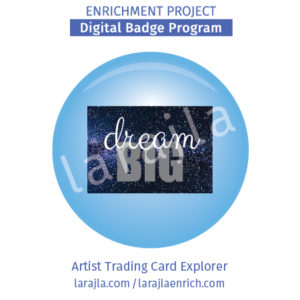
Artist trading cards are small pieces of art. They can be made with multiple different materials in a variety of art and / or craft techniques. Let’s see what others have done with this type of card.
Steps
1. Search.
Start with a general search for artist trading cards or ATCs. You’ll see that they are all similarly sized. As per standard trading cards, they are designed to fit into storage that accommodates trading cards. Look at some examples to see what others have done. Be sure to save those that inspire you.
NOTE: The Flickr link in the “Sites to Explore” is to my album with a few of the ATCs I’ve made.
2. ATCs.
Besides the size, artist trading cards must also be just that . . . traded. Check out swap-bot.com to see what people are trading online through planned exchanges. Explore the themes and requirements for the swaps. If you see something you want to try, you may want to jump in after completing “Artist Trading Card Basics.”
3. ACEOs.
A second level of artist trading cards exist . . . ACEOs. This stands for Art Cards Editions and Originals. While ATCs are traded, ACEOs are sold. For this reason, copyright becomes a big part of this level. Check out some ACEOs to see the difference.
4. Theme.
When you get involved in a planned swap, it often revolves around a theme. That might be a color, book, movie, season, holiday or anything else. Track the themes that interest you. How might you create your own cards to fit in the theme?
5. Background.
Look at the backgrounds of ATCs. Most are paper, but that is not always the case. Note any other mediums you might want to try as a base.
6. Embellish.
Almost any embellishment can be used on an ATC. As you look at ATCs, make notes of items that are added to the cards. Are there items you prefer to work with? If so, look for those items to see how others work with them on their ATCs.
7. Technique.
Sometimes the “theme” may be a paper technique to use on a card. Techniques might include quilling, teabag folding, iris folding, dry embossing or rubber stamping. A specific type of ephemera might be used . . . especially if it is provided by the person hosting the swap.
There are other “techniques” that are more restrictions. For example, it might need to include beads or it might need to remain flat to fit into a page protector designed to hold trading cards. Look at techniques and / or restrictions that are included with designing ATCs for a swap.
8. Local.
I mentioned Swap-Bot, but local craft stores may host ATC swaps. I used to participate with a local paper / scrapbooking store until it closed. It’s better to see an ATC in person as you can examine it and see how the creator put it together.
If you don’t have a local store so you can participate that way, check out artist groups and art museums as well. You never know where you may find people who enjoy making these pocket-sized pieces of art.
9. Kids.
As you’re looking at ATCs, remember most of these are made by adults. However, they are a wonderful craft for kids as well. It allows freedom of expression without structured guidelines of how one needs to be made. Watch for ATCs made by kids to see the differences in how it looks and the techniques used.
Badge and Supplement Files
Member Level
- EP_Badge List_ATC Explorer_larajla — list of badge items
- EP_Badge Set_ATC Explorer_larajla — list of badge set and related badges
- EP_Supp_List_ATC Explorer_larajla — list of supplements for the badge
- SUPP_BPG_ATC Explorer_2in_12up_larajla — generic badge printable
- SUPP_ATC Explorer_Journal_larajla — badge journal
- SUPP_ATC Explorer_Planner_larajla — badge planner
Supplement Fun
- N/A
Sites to Explore
- www.atcsforall.com
- www.art-e-zine.co.uk/atcnov03.html
- www.swap-bot.com
- en.wikipedia.org/wiki/Artist_trading_cards
- www.pinterest.com/caroltadden/artist-trading-cards
- www.illustratedatcs.com
- www.flickr.com/photos/28598163@N04/albums/72157628058870541
Get the infographic here > larajla blog post
Get the PDFs of the badge program / supplements here